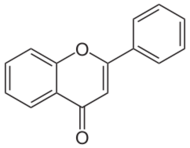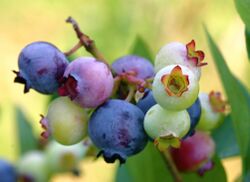Chemistry:Flavonoid
Flavonoids (or bioflavonoids; from the Latin word flavus, meaning yellow, their color in nature) are a class of polyphenolic secondary metabolites found in plants, and thus commonly consumed in the diets of humans.[1]
Chemically, flavonoids have the general structure of a 15-carbon skeleton, which consists of two phenyl rings (A and B) and a heterocyclic ring (C, the ring containing the embedded oxygen).[1][2] This carbon structure can be abbreviated C6-C3-C6. According to the IUPAC nomenclature,[3][4] they can be classified into:
- flavonoids or bioflavonoids
- isoflavonoids, derived from 3-phenylchromen-4-one (3-phenyl-1,4-benzopyrone) structure
- neoflavonoids, derived from 4-phenylcoumarin (4-phenyl-1,2-benzopyrone) structure
The three flavonoid classes above are all ketone-containing compounds and as such, anthoxanthins (flavones and flavonols).[1] This class was the first to be termed bioflavonoids. The terms flavonoid and bioflavonoid have also been more loosely used to describe non-ketone polyhydroxy polyphenol compounds, which are more specifically termed flavanoids. The three cycles or heterocycles in the flavonoid backbone are generally called ring A, B, and C.[2] Ring A usually shows a phloroglucinol substitution pattern.
History
In the 1930s, Albert Szent-Györgyi and other scientists discovered that Vitamin C alone was not as effective at preventing scurvy as the crude yellow extract from oranges, lemons or paprika. They attributed the increased activity of this extract to the other substances in this mixture, which they referred to as "citrin" (referring to citrus) or "Vitamin P" (a reference to its effect on reducing the permeability of capillaries). The substances in question (hesperidin, eriodictyol, hesperidin methyl chalcone and neohesperidin) were however later shown not to fulfil the criteria of a vitamin,[5] so that this term is now obsolete.[6]
Biosynthesis
Flavonoids are secondary metabolites synthesized mainly by plants. The general structure of flavonoids is a 15-carbon skeleton, containing 2 benzene rings connected by a 3-carbon linking chain.[1] Therefore, they are depicted as C6-C3-C6 compounds. Depending on the chemical structure, degree of oxidation, and unsaturation of the linking chain (C3), flavonoids can be classified into different groups, such as anthocyanidins, flavonols, flavanones, flavan-3-ols, flavanonols, flavones, and isoflavones.[1] Chalcones, also called chalconoids, although lacking the heterocyclic ring, are also classified as flavonoids. Furthermore, flavonoids can be found in plants in glycoside-bound and free aglycone forms. The glycoside-bound form is the most common flavone and flavonol form consumed in the diet.[1]
Functions of flavonoids in plants
Flavonoids are widely distributed in plants, fulfilling many functions.[1] They are the most important plant pigments for flower coloration, producing yellow or red/blue pigmentation in petals designed to attract pollinator animals. In higher plants, they are involved in UV filtration, symbiotic nitrogen fixation, and floral pigmentation. They may also act as chemical messengers, physiological regulators, and cell cycle inhibitors. Flavonoids secreted by the root of their host plant help Rhizobia in the infection stage of their symbiotic relationship with legumes like peas, beans, clover, and soy. Rhizobia living in soil are able to sense the flavonoids and this triggers the secretion of Nod factors, which in turn are recognized by the host plant and can lead to root hair deformation and several cellular responses such as ion fluxes and the formation of a root nodule. In addition, some flavonoids have inhibitory activity against organisms that cause plant diseases, e.g. Fusarium oxysporum.[7]
Subgroups
Over 5000 naturally occurring flavonoids have been characterized from various plants. They have been classified according to their chemical structure, and are usually subdivided into the following subgroups (for further reading see[8]):
Anthocyanidins
Anthocyanidins are the aglycones of anthocyanins; they use the flavylium (2-phenylchromenylium) ion skeleton.[1]
- Examples: Cyanidin, Delphinidin, Malvidin, Pelargonidin, Peonidin, Petunidin
Anthoxanthins
Anthoxanthins are divided into two groups:[9]
| Group | Skeleton | Examples | |||
|---|---|---|---|---|---|
| Description | Functional groups | Structural formula | |||
| 3-hydroxyl | 2,3-dihydro | ||||
| Flavone | 2-phenylchromen-4-one | ✗ | ✗ | 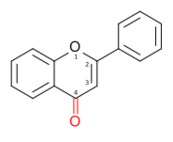
|
Luteolin, Apigenin, Tangeritin |
| Flavonol or 3-hydroxyflavone |
3-hydroxy-2-phenylchromen-4-one | ✓ | ✗ | 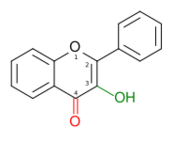
|
Quercetin, Kaempferol, Myricetin, Fisetin, Galangin, Isorhamnetin, Pachypodol, Rhamnazin, Pyranoflavonols, Furanoflavonols, |
Flavanones
| Group | Skeleton | Examples | |||
|---|---|---|---|---|---|
| Description | Functional groups | Structural formula | |||
| 3-hydroxyl | 2,3-dihydro | ||||
| Flavanone | 2,3-dihydro-2-phenylchromen-4-one | ✗ | ✓ | 
|
Hesperetin, Naringenin, Eriodictyol, Homoeriodictyol |
Flavanonols
Flavanonols
| Group | Skeleton | Examples | |||
|---|---|---|---|---|---|
| Description | Functional groups | Structural formula | |||
| 3-hydroxyl | 2,3-dihydro | ||||
| Flavanonol or 3-Hydroxyflavanone or 2,3-dihydroflavonol |
3-hydroxy-2,3-dihydro-2-phenylchromen-4-one | ✓ | ✓ | 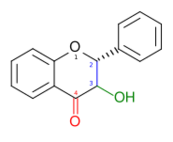
|
Taxifolin (or Dihydroquercetin), Dihydrokaempferol |
Flavans
Include flavan-3-ols (flavanols), flavan-4-ols and flavan-3,4-diols.
| Skeleton | Name |
|---|---|

|
Flavan-3-ol (flavanol) |

|
Flavan-4-ol |

|
Flavan-3,4-diol (leucoanthocyanidin) |
- Flavan-3-ols (flavanols)
- Flavan-3-ols use the 2-phenyl-3,4-dihydro-2H-chromen-3-ol skeleton
- Examples: Catechin (C), Gallocatechin (GC), Catechin 3-gallate (Cg), Gallocatechin 3-gallate (GCg), Epicatechins (Epicatechin (EC)), Epigallocatechin (EGC), Epicatechin 3-gallate (ECg), Epigallocatechin 3-gallate (EGCg)
- Examples: Theaflavin-3-gallate, Theaflavin-3'-gallate, Theaflavin-3,3'-digallate
- Thearubigin
- Proanthocyanidins are dimers, trimers, oligomers, or polymers of the flavanols
Isoflavonoids
- Isoflavonoids
- Isoflavones use the 3-phenylchromen-4-one skeleton (with no hydroxyl group substitution on carbon at position 2)
- Isoflavanes
- Isoflavandiols
- Isoflavenes
- Coumestans
- Pterocarpans
Dietary sources
Flavonoids (specifically flavanoids such as the catechins) are "the most common group of polyphenolic compounds in the human diet and are found ubiquitously in plants".[1][10] Flavonols, the original bioflavonoids such as quercetin, are also found ubiquitously, but in lesser quantities. The widespread distribution of flavonoids, their variety and their relatively low toxicity compared to other active plant compounds (for instance alkaloids) mean that many animals, including humans, ingest significant quantities in their diet.[1] Foods with a high flavonoid content include parsley,[11] onions,[11] blueberries and other berries,[11] black tea,[11] green tea and oolong tea,[11] bananas, all citrus fruits, Ginkgo biloba, red wine, sea-buckthorns, buckwheat,[12] and dark chocolate with a cocoa content of 70% or greater.
Parsley
Parsley, both fresh and dried, contains flavones.[11]
Blueberries
Blueberries are a dietary source of anthocyanidins.[11][13]
Black tea
Black tea is a rich source of dietary flavan-3-ols.[11]
Citrus
The citrus flavonoids include hesperidin (a glycoside of the flavanone hesperetin), quercitrin, rutin (two glycosides of the flavonol quercetin), and the flavone tangeritin. The flavonoids are much less concentrated in the pulp than in the peels (for example, 165 vs. 1156 mg/100 g in pulp vs. peel of satsuma mandarin, and 164 vis-à-vis 804 mg/100 g in pulp vs. peel of clementine).[14]
Wine
Cocoa
Flavonoids exist naturally in cocoa, but because they can be bitter, they are often removed from chocolate, even dark chocolate.[15] Although flavonoids are present in milk chocolate, milk may interfere with their absorption;[16] however, this conclusion has been questioned.[17]
Peanut
Peanut (red) skin contains significant polyphenol content, including flavonoids.[18][19]
| Food source | Flavones | Flavonols | Flavanones |
|---|---|---|---|
| Red onion | 0 | 4 - 100 | 0 |
| Parsley, fresh | 24 - 634 | 8 - 10 | 0 |
| Thyme, fresh | 56 | 0 | 0 |
| Lemon juice, fresh | 0 | 0 - 2 | 2 - 175 |
Unit: mg/100g[1]
Dietary intake

Food composition data for flavonoids were provided by the USDA database on flavonoids.[11] In the United States NHANES survey, mean flavonoid intake was 190 mg/d in adults, with flavan-3-ols as the main contributor.[21] In the European Union, based on data from EFSA, mean flavonoid intake was 140 mg/d, although there were considerable differences among individual countries.[20] The main type of flavonoids consumed in the EU and USA were flavan-3-ols (80% for USA adults), mainly from tea or cocoa in chocolate, while intake of other flavonoids was considerably lower.[1][20][21]

Research
Neither the United States Food and Drug Administration (FDA) nor the European Food Safety Authority (EFSA) has approved any flavonoids as prescription drugs.[1][22][23][24] The U.S. FDA has warned numerous dietary supplement and food manufacturers, including Unilever, producer of Lipton tea in the U.S., about illegal advertising and misleading health claims regarding flavonoids, such as that they lower cholesterol or relieve pain.[25][26]
Metabolism and excretion
Flavonoids are poorly absorbed in the human body (less than 5%), then are quickly metabolized into smaller fragments with unknown properties, and rapidly excreted.[1][24][27][28] Flavonoids have negligible antioxidant activity in the body, and the increase in antioxidant capacity of blood seen after consumption of flavonoid-rich foods is not caused directly by flavonoids, but by production of uric acid resulting from flavonoid depolymerization and excretion.[1] Microbial metabolism is a major contributor to the overall metabolism of dietary flavonoids.[1][29] The effect of habitual flavonoid intake on the human gut microbiome is unknown.[1][30]
Inflammation
Inflammation has been implicated as a possible origin of numerous local and systemic diseases, such as cancer,[31] cardiovascular disorders,[32] diabetes mellitus,[33] and celiac disease.[34] There is no clinical evidence that dietary flavonoids affect any of these diseases.[1]
Cancer
Clinical studies investigating the relationship between flavonoid consumption and cancer prevention or development are conflicting for most types of cancer, probably because most human studies have weak designs, such as a small sample size.[1][35] There is little evidence to indicate that dietary flavonoids affect human cancer risk in general.[1]
Cardiovascular diseases
Although no significant association has been found between flavan-3-ol intake and cardiovascular disease mortality, clinical trials have shown improved endothelial function and reduced blood pressure (with a few studies showing inconsistent results).[1] Reviews of cohort studies in 2013 found that the studies had too many limitations to determine a possible relationship between increased flavonoid intake and decreased risk of cardiovascular disease, although a trend for an inverse relationship existed.[1][36]
In 2013, the EFSA decided to permit health claims that 200 mg/day of cocoa flavanols "help[s] maintain the elasticity of blood vessels."[37][38] The FDA followed suit in 2023, stating that there is "supportive, but not conclusive" evidence that 200 mg/day of cocoa flavanols can reduce the risk of cardiovascular disease. This is greater than the levels found in typical chocolate bars, which can also contribute to weight gain, potentially harming cardiovascular health.[39][40]
Synthesis, detection, quantification, and semi-synthetic alterations
Color spectrum
Flavonoid synthesis in plants is induced by light color spectrums at both high and low energy radiations. Low energy radiations are accepted by phytochrome, while high energy radiations are accepted by carotenoids, flavins, cryptochromes in addition to phytochromes. The photomorphogenic process of phytochrome-mediated flavonoid biosynthesis has been observed in Amaranthus, barley, maize, Sorghum and turnip. Red light promotes flavonoid synthesis.[41]
Availability through microorganisms
Several recent research articles have demonstrated the efficient production of flavonoid molecules from genetically engineered microorganisms.[42][43][44] and the project SynBio4Flav[45][46] aims to provide a cost-effective alternative to current flavonoid production breaking down their complex biosynthetic pathways into standardized specific parts, which can be transferred to engineered microorganisms within Synthetic Microbial Consortia to promote flavonoid assembly through distributed catalysis.
Tests for detection
- Shinoda test
Four pieces of magnesium filings are added to the ethanolic extract followed by few drops of concentrated hydrochloric acid. A pink or red colour indicates the presence of flavonoid.[47] Colours varying from orange to red indicated flavones, red to crimson indicated flavonoids, crimson to magenta indicated flavonones.
- Sodium hydroxide test
About 5 mg of the compound is dissolved in water, warmed, and filtered. 10% aqueous sodium hydroxide is added to 2 ml of this solution. This produces a yellow coloration. A change in color from yellow to colorless on addition of dilute hydrochloric acid is an indication for the presence of flavonoids.[48]
- p-Dimethylaminocinnamaldehyde test
A colorimetric assay based upon the reaction of A-rings with the chromogen p-dimethylaminocinnamaldehyde (DMACA) has been developed for flavanoids in beer that can be compared with the vanillin procedure.[49]
Quantification
Lamaison and Carnet have designed a test for the determination of the total flavonoid content of a sample (AlCI3 method). After proper mixing of the sample and the reagent, the mixture is incubated for ten minutes at ambient temperature and the absorbance of the solution is read at 440 nm. Flavonoid content is expressed in mg/g of quercetin.[50]
Semi-synthetic alterations
Immobilized Candida antarctica lipase can be used to catalyze the regioselective acylation of flavonoids.[51]
See also
- Phytochemical
- List of antioxidants in food
- List of phytochemicals in food
- Phytochemistry
- Secondary metabolites
- Homoisoflavonoids, related chemicals with a 16 carbons skeleton
References
- ↑ 1.00 1.01 1.02 1.03 1.04 1.05 1.06 1.07 1.08 1.09 1.10 1.11 1.12 1.13 1.14 1.15 1.16 1.17 1.18 1.19 1.20 1.21 "Flavonoids". Linus Pauling Institute, Oregon State University, Corvallis, Oregon. November 2015. http://lpi.oregonstate.edu/mic/dietary-factors/phytochemicals/flavonoids.
- ↑ 2.0 2.1 "Analysis of Conformational, Structural, Magnetic, and Electronic Properties Related to Antioxidant Activity: Revisiting Flavan, Anthocyanidin, Flavanone, Flavonol, Isoflavone, Flavone, and Flavan-3-ol". ACS Omega 6 (13): 8908–8918. April 2021. doi:10.1021/acsomega.0c06156. PMID 33842761.
- ↑ IUPAC Compendium of Chemical Terminology (2nd ed.), Oxford: Blackwell Scientific, 1997, doi:10.1351/goldbook.F02424, ISBN 978-0-9678550-9-7
- ↑ "Flavonoids (isoflavonoids and neoflavonoids)", The Gold Book, 2009, doi:10.1351/goldbook, ISBN 978-0-9678550-9-7, http://goldbook.iupac.org, retrieved 16 September 2012
- ↑ (in en) Vitamins and Hormones. Academic Press. 1949. ISBN 978-0-08-086604-8. https://books.google.com/books?id=hc1TyKSumOkC&pg=PA210.
- ↑ Clemetson, Alan B. (2018-01-10) (in en). Vitamin C: Volume I. CRC Press. ISBN 978-1-351-08601-1. https://books.google.com/books?id=1kgPEAAAQBAJ&pg=PA101.
- ↑ "Flavonoids from carnation (Dianthus caryophyllus) and their antifungal activity". Phytochemistry Letters 1 (1): 44–48. 2008. doi:10.1016/j.phytol.2007.10.001. Bibcode: 2008PChL....1...44G.
- ↑ "Biotechnology of flavonoids and other phenylpropanoid-derived natural products. Part I: Chemical diversity, impacts on plant biology and human health". Biotechnology Journal 2 (10): 1214–34. October 2007. doi:10.1002/biot.200700084. PMID 17935117.
- ↑ Isolation of a UDP-glucose: Flavonoid 5-O-glucosyltransferase gene and expression analysis of anthocyanin biosynthetic genes in herbaceous peony (Paeonia lactiflora Pall.). Da Qiu Zhao, Chen Xia Han, Jin Tao Ge and Jun Tao, Electronic Journal of Biotechnology, 15 November 2012, Volume 15, Number 6, doi:10.2225/vol15-issue6-fulltext-7
- ↑ "Flavonoids: modulators of brain function?". The British Journal of Nutrition 99 E Suppl 1 (E-S1): ES60-77. May 2008. doi:10.1017/S0007114508965776. PMID 18503736.
- ↑ 11.0 11.1 11.2 11.3 11.4 11.5 11.6 11.7 11.8 USDA’s Database on the Flavonoid Content
- ↑ "Flavonoids and Antioxidative Activities in Buckwheat". Journal of Agricultural and Food Chemistry 44 (7): 1746–1750. 1996. doi:10.1021/jf9508357.
- ↑ "Antioxidants and bioactivities of free, esterified and insoluble-bound phenolics from berry seed meals". Food Chemistry 197 (Pt A): 221–32. April 2016. doi:10.1016/j.foodchem.2015.10.107. PMID 26616944.
- ↑ Levaj B; others (2009). "Determination of flavonoids in pulp and peel of mandarin fruits (table 1)". Agriculturae Conspectus Scientificus 74 (3): 223. http://www.agr.unizg.hr/smotra/pdf_74/acs74_38.pdf.
- ↑ The Lancet (December 2007). "The devil in the dark chocolate". Lancet 370 (9605): 2070. doi:10.1016/S0140-6736(07)61873-X. PMID 18156011.
- ↑ "Plasma antioxidants from chocolate". Nature 424 (6952): 1013. August 2003. doi:10.1038/4241013a. PMID 12944955. Bibcode: 2003Natur.424.1013S. http://eprints.gla.ac.uk/131/1/Crozier%2CA_2003.pdf.
- ↑ "Milk does not affect the bioavailability of cocoa powder flavonoid in healthy human". Annals of Nutrition & Metabolism 51 (6): 493–8. 2007. doi:10.1159/000111473. PMID 18032884.[yes|permanent dead link|dead link}}]
- ↑ "Gamma-irradiation induced changes in microbiological status, phenolic profile and antioxidant activity of peanut skin". Journal of Functional Foods 12: 129–143. 2015. doi:10.1016/j.jff.2014.10.034.
- ↑ "Peanut skin color: a biomarker for total polyphenolic content and antioxidative capacities of peanut cultivars". International Journal of Molecular Sciences 10 (11): 4941–52. November 2009. doi:10.3390/ijms10114941. PMID 20087468.
- ↑ 20.0 20.1 20.2 20.3 "Flavonoid intake in European adults (18 to 64 years)". PLOS ONE 10 (5): e0128132. 2015. doi:10.1371/journal.pone.0128132. PMID 26010916. Bibcode: 2015PLoSO..1028132V.
- ↑ 21.0 21.1 "Estimated dietary flavonoid intake and major food sources of U.S. adults". The Journal of Nutrition 137 (5): 1244–52. May 2007. doi:10.1093/jn/137.5.1244. PMID 17449588.
- ↑ "FDA approved drug products". US Food and Drug Administration. http://www.accessdata.fda.gov/scripts/cder/drugsatfda/index.cfm.
- ↑ "Health Claims Meeting Significant Scientific Agreement". US Food and Drug Administration. https://www.fda.gov/Food/IngredientsPackagingLabeling/LabelingNutrition/ucm2006876.htm#Approved_Health_Claims.
- ↑ 24.0 24.1 EFSA Panel on Dietetic Products, Nutrition and Allergies (NDA) (2010). "Scientific Opinion on the substantiation of health claims related to various food(s)/food constituent(s) and protection of cells from premature aging, antioxidant activity, antioxidant content and antioxidant properties, and protection of DNA, proteins and lipids from oxidative damage pursuant to Article 13(1) of Regulation (EC) No 1924/20061". EFSA Journal 8 (2): 1489. doi:10.2903/j.efsa.2010.1489.
- ↑ Hensley, Scott (September 7, 2010). "FDA To Lipton: Tea Can't Do That". https://www.npr.org/sections/health-shots/2010/09/07/129701566/fda-to-lipton-tea-can-t-do-that.
- ↑ "Cherry companies warned by FDA against making health claims". November 1, 2005. https://theproducenews.com/cherry-companies-warned-fda-against-making-health-claims.
- ↑ "Consumption of flavonoid-rich foods and increased plasma antioxidant capacity in humans: cause, consequence, or epiphenomenon?". Free Radical Biology & Medicine 41 (12): 1727–46. December 2006. doi:10.1016/j.freeradbiomed.2006.04.033. PMID 17157175.
- ↑ "Flavonoids: antioxidants or signalling molecules?". Free Radical Biology & Medicine 36 (7): 838–49. April 2004. doi:10.1016/j.freeradbiomed.2004.01.001. PMID 15019969.
- ↑ "Metabolism of anthocyanins by human gut microflora and their influence on gut bacterial growth". Journal of Agricultural and Food Chemistry 60 (15): 3882–90. April 2012. doi:10.1021/jf3002153. PMID 22439618.
- ↑ "Role of Dietary Flavonoid Compounds in Driving Patterns of Microbial Community Assembly". mBio 10 (5). September 2019. doi:10.1128/mBio.01205-19. PMID 31551328.
- ↑ "Flavonoids as prospective compounds for anti-cancer therapy". The International Journal of Biochemistry & Cell Biology 45 (12): 2821–31. December 2013. doi:10.1016/j.biocel.2013.10.004. PMID 24128857.
- ↑ "Polyphenols and prevention of cardiovascular diseases". Current Opinion in Lipidology 16 (1): 77–84. February 2005. doi:10.1097/00041433-200502000-00013. PMID 15650567.
- ↑ "Recent advances in understanding the anti-diabetic actions of dietary flavonoids". The Journal of Nutritional Biochemistry 24 (11): 1777–89. November 2013. doi:10.1016/j.jnutbio.2013.06.003. PMID 24029069.
- ↑ "Celiac disease, inflammation and oxidative damage: a nutrigenetic approach". Nutrients 4 (4): 243–57. April 2012. doi:10.3390/nu4040243. PMID 22606367.
- ↑ "Flavonoids and cancer prevention: a review of the evidence". Journal of Nutrition in Gerontology and Geriatrics 31 (3): 206–38. 2012. doi:10.1080/21551197.2012.702534. PMID 22888839.
- ↑ "Flavonoid intake and risk of CVD: a systematic review and meta-analysis of prospective cohort studies". The British Journal of Nutrition 111 (1): 1–11. January 2014. doi:10.1017/S000711451300278X. PMID 23953879.
- ↑ "Scientific Opinion on the substantiation of a health claim related to cocoa flavanols and maintenance of normal endothelium-dependent vasodilation pursuant to Article 13(5) of Regulation (EC) No 1924/2006". EFSA Journal 10 (7). June 27, 2012. doi:10.2903/j.efsa.2012.2809. https://www.efsa.europa.eu/pt/efsajournal/pub/2809. Retrieved 2023-06-17.
- ↑ "Cocoa flavanol health claim becomes EU law". September 4, 2013. https://www.confectionerynews.com/Article/2013/09/04/Cocoa-flavanol-health-claim-becomes-EU-law.
- ↑ Claudine Kavanaugh (February 1, 2023). RE: Petition for a Qualified Health Claim – for Cocoa Flavanols and Reduced Risk of Cardiovascular Disease (Docket No. FDA-2019-Q-0806) (Report). FDA. https://www.fda.gov/media/165090/download?utm_medium=email&utm_source=govdelivery.
- ↑ Aubrey, Allison (February 12, 2023). "Is chocolate good for your heart? Finally the FDA has an answer – kind of". https://www.npr.org/sections/health-shots/2023/02/12/1156044919/chocolate-heart-health-flavanols.
- ↑ (in en) Modern Plant Physiology. CRC Press. 2004-01-01. p. 457. ISBN 9780849317149. https://books.google.com/books?id=03S6VbTjCmUC.
- ↑ "Production of plant-specific flavanones by Escherichia coli containing an artificial gene cluster". Applied and Environmental Microbiology 69 (5): 2699–706. May 2003. doi:10.1128/AEM.69.5.2699-2706.2003. PMID 12732539. Bibcode: 2003ApEnM..69.2699H.
- ↑ "Metabolic engineering of the complete pathway leading to heterologous biosynthesis of various flavonoids and stilbenoids in Saccharomyces cerevisiae". Metabolic Engineering 11 (6): 355–66. November 2009. doi:10.1016/j.ymben.2009.07.004. PMID 19631278.
- ↑ "Biotechnology of flavonoids and other phenylpropanoid-derived natural products. Part II: Reconstruction of multienzyme pathways in plants and microbes". Biotechnology Journal 2 (10): 1235–49. October 2007. doi:10.1002/biot.200700184. PMID 17935118.
- ↑ "SynBio4Flav | boosting the standardization of high complexity synthetic biological parts". https://synbio4flav.eu/.
- ↑ "Synthetic microbial consortia-based platform for flavonoids production using synthetic biology | H2020 | European Commission". https://cordis.europa.eu/project/id/814650.
- ↑ Yisa, Jonathan (2009). "Phytochemical Analysis and Antimicrobial Activity Of Scoparia Dulcis and Nymphaea Lotus". Australian Journal of Basic and Applied Sciences 3 (4): 3975–3979. http://connection.ebscohost.com/c/articles/51366872/phytochemical-analysis-antimicrobial-activity-scoparia-dulcis-nymphaea-lotus.
- ↑ "A bioactive flavonoid from Pavetta crassipes K. Schum". Organic and Medicinal Chemistry Letters 1 (1): 14. October 2011. doi:10.1186/2191-2858-1-14. PMID 22373191.
- ↑ "A New Colourimetric Assay for Flavanoids in Pilsner Beers". Journal of the Institute of Brewing 91: 37–40. 1985. doi:10.1002/j.2050-0416.1985.tb04303.x.
- ↑ Lamaison, JL; Carnet, A (1991). "Teneurs en principaux flavonoides des fleurs de Cratageus monogyna Jacq et de Cratageus Laevigata (Poiret D.C) en Fonction de la vegetation". Plantes Medicinales Phytotherapie 25: 12–16.
- ↑ "Regioselective acylation of flavonoids catalyzed by immobilized Candida antarctica lipase under reduced pressure". Biotechnology Letters 26 (13): 1073–6. July 2004. doi:10.1023/B:BILE.0000032967.23282.15. PMID 15218382.
Further reading
- 'Flavonoids: Chemistry, Biochemistry and Applications. Boca Raton, FL: CRC Press, Taylor & Francis. 2006. ISBN 978-0-8493-2021-7.
- The science of flavonoids. New York: Springer. 2006. ISBN 978-0-387-74550-3.
- Comparative Biochemistry of the Flavonoids. 1967. https://books.google.com/books?id=CyTf2oObc7cC.
- l.a.g (1971). "The systematic identification of flavonoids". Journal of Molecular Structure 10 (2): 320. doi:10.1016/0022-2860(71)87109-0.
Databases
- USDA Database for the Flavonoid Content of Selected Foods, Release 3.1 (December 2013); data for 506 foods in the 5 subclasses of flavonoids provided in a separate PDF updated May 2014
- FlavoDB, Bioinformatics Centre, India, November 2019
 |
